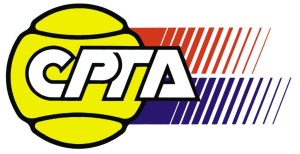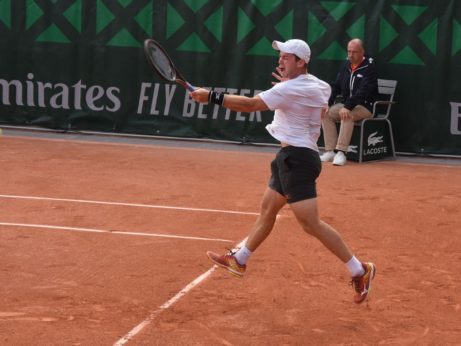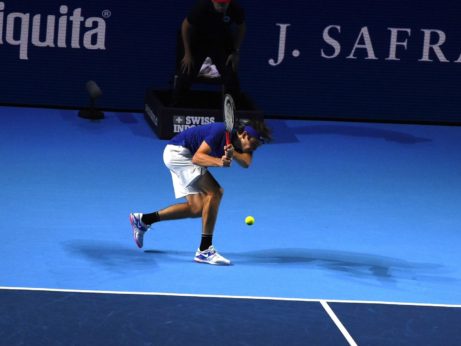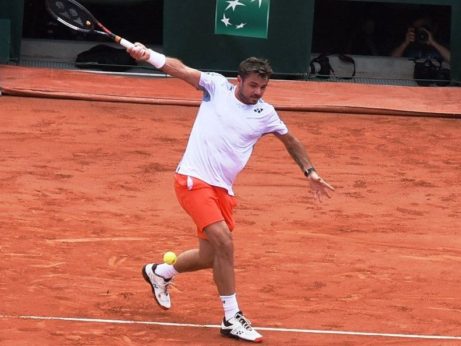Jack Sock – Strong service and forehand combination
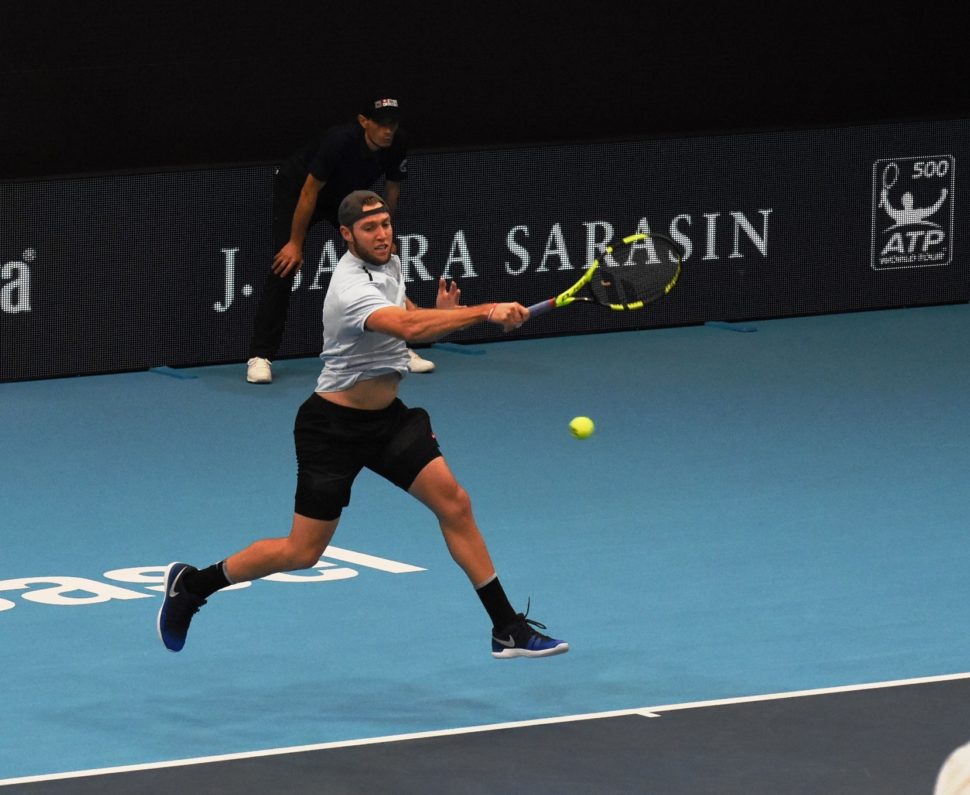
Jack Sock (*92 / USA) of Kansas City was after a few years of certain stagnation the shooting start of the end of the 2017 season. After his win at the 2017 Paris Masters, Jack had a very strong showing at the ATP Masters in London, where he reached the semifinals. There he lost in 3 sets to the eventual event winner Grigor Dimitrov (BUL). As a result, Jack is closing the 2017 season at the ATP #8, which is obviously his career high and it took more than 6 years for an American male tennis player to be ranked so high. The last, before him, was former #1 Andy Roddick, who was ranked at the position of #8 in March 2011. Interestingly enough, both Rodick and Sock were born in Nebraska…
In the previous articles here, I have written about Jacks Forehand 3.0 as well as about his Service 3.0. In this article, I would like to focus on the combination of these two, which is currently one of Jack’s biggest strengths. Today, he can combine these strokes at a much higher level than for example young American Ernesto Escobedo, about whom I have written here as well already. In the modern game then, the efficient stoke combinations (mainly service & 3rd stroke as well as return & 4th stroke) are the real deciding elements in the game of the top players, isolated single strokes are not enough anymore. The best players have the ability to hit very well-placed
In general, Jack has mastered in both mentioned strokes the art of the close to optimal body energy unloading (=Tennis 3.0), which flows through the targeted pronation of the entire limb (long-axis pronation) exactly against the target. Such targeted pronation is possible when, among other conditions (= TENNIS 3.0 CODE), a perfect eye control of the ball leading to optimal spacing is present. Some of the other conditions necessary for a perfect spacing, which is making the efficient and well-controlled body energy unloading against the target possible, are a clear mental picture of such stroke, an early anticipation, a good ball perception, a good use of the non-dominant hand, a prolonged mental engagement with each stroke and a fairly good footwork with a solid feet frequency.
In my personal opinion, a wrong mental image of the strokes and a too short mental engagement span (both often tied to the “consumer mentality” of the players) with each stroke are the most prevalent mistakes among the aspiring players. For the seamless stroke combinations, also an early split step tied to the hitting of the opponent and full focus on opponent’s body and racket action is essential. The end result is not mainly about the biomechanical aspects of the strokes, as many think, but much rather about the combination of the biomechanical, mental and emotional factors, which in combination create the stroke technique and the style of play of each player!
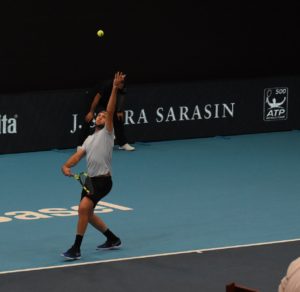
Jack Sock (*92 / USA) – Service 3.0 & Forehand 3.0 combination in the match – 1 of 7 – toss – great eye control of the released ball, the take-back of the racket is just starting – 2017 Swiss Indoors – Basel / Switzerland
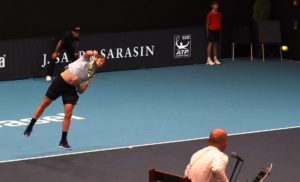
Jack Sock (*92 / USA) – Service3.0 & Forehand 3.0 combination in the match – 2 of 7 – service follow through 1 = targeted pronation with solid body energy integration into the stroke – 2017 Swiss Indoors – Basel / Switzerland
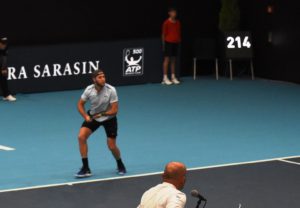
Jack Sock (*92 / USA) – Service 3.0 & Forehand 3.0 combination in the match – 3 of 7 – the first reaction after the split-step – the activation of the outside (right) leg, the service was clicked at 214 km/h = 135 mph – 2017 Swiss Indoors – Basel / Switzerland
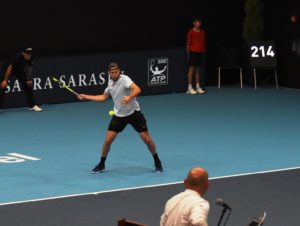
Jack Sock (*92 / USA) – Service 3.0 & Forehand 3.0 combination in the match – 4 of 7 – start of the racket acceleration against the ball from a comfortable wide stance – the wrist is locked much earlier than some months ago, good eye control, solid space developed also thanks to the cooperation of the non-dominant (left) arm – 2017 Swiss Indoors – Basel / Switzerland
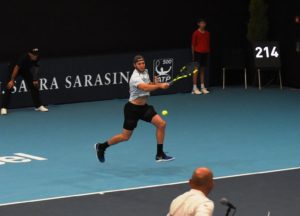
Jack Sock (*92 / USA) – Service 3.0 & Forehand 3.0 combination in the match – 5 of 7 – follow through 1 = targeted pronation – both the racket and the elbow travel far away from the body center against the target, this leads to an efficient and well-controlled body energy unloading against the intended target – such an action needs a clear vision/goal setting – 2017 Swiss Indoors – Basel / Switzerland

Jack Sock (*92 / USA) – Service 3.0 & Forehand 3.0 combination in the match – 6 of 7 – follow through 2 = relaxation – very well-controlled without excessive racket activity as most of the energy was spent already – 2017 Swiss Indoors – Basel / Switzerland
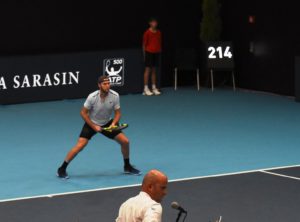
Jack Sock (*92 / USA) – Service 3.0 & Forehand 3.0 combination in the match – 7 of 7 – landing in the deep split-step and thus getting well ready for the following action (which was not necessary in this case as Jack’s 3rd stroke made the opponent to hit an error) – 2017 Swiss Indoors – Basel / Switzerland
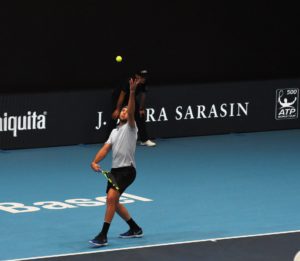
Jack Sock (*92 / USA) – Service 3.0 & Forehand 3.0 combination – 1 of 10 – toss – typical for Jack is delayed racket take-back – 2017 Swiss Indoors – Basel / Switzerland
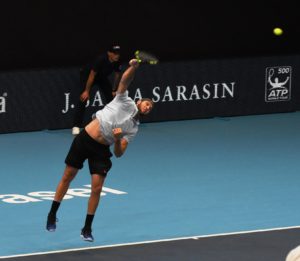
Jack Sock (*92 / USA) – Service 3.0 & Forehand 3.0 combination – 2 of 10 – follow through 1 = targeted pronation – here rather slower and not complete, which results in slower 1st service – 2017 Swiss Indoors – Basel / Switzerland

Jack Sock (*92 / USA) – Service 3.0 & Forehand 3.0 combination – 3 of 10 – end of follow through 1 – the palm is still facing to the outside, Jack’s center of gravity is clearly in the court – 2017 Swiss Indoors – Basel / Switzerland
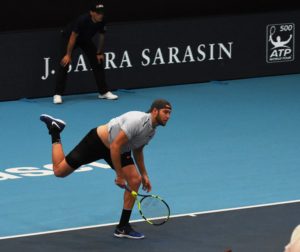
Jack Sock (*92 / USA) – Service 3.0 & Forehand 3.0 combination – 4 of 10 – start of follow through 2 = relaxation – palm turns to the inside, well-absorbed landing in the court, eyes are focused at the action of the opponent – 2017 Swiss Indoors – Basel / Switzerland
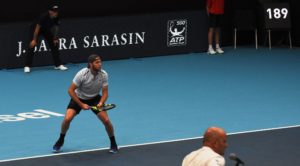
Jack Sock (*92 / USA) – Service 3.0 & Forehand 3.0 combination – 5 of 10 – after a jump back landing in a wide split-step and the decision about the next stroke being the forehand was just made – the preparation started already. As the service pronation was less dynamic this time, the speed of the service was slightly lower – 189 km/h = 118 mph – 2017 Swiss Indoors – Basel / Switzerland
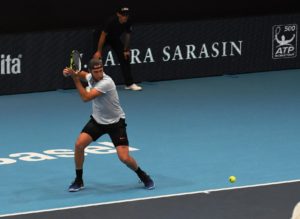
Jack Sock (*92 / USA) – Service 3.0 & Forehand 3.0 combination – 6 of 10 – high backswing pivot with a very active role of the non-dominant (left) arm, optimal eye control of the incoming ball and good spacing – 2017 Swiss Indoors – Basel / Switzerland
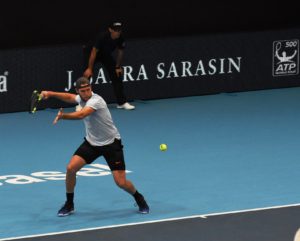
Jack Sock (*92 / USA) – Service 3.0 & Forehand 3.0 combination – 7 of 10 – Jack’s specific backswing creating high degree of pretension in his entire upper limb, the non-dominant (left) arm stabilizes the position and controls the space – 2017 Swiss Indoors – Basel / Switzerland
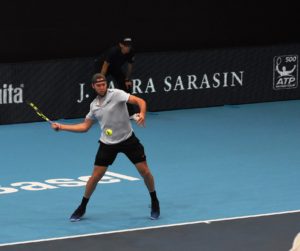
Jack Sock (*92 / USA) – Service 3.0 & Forehand 3.0 combination – 8 of 10 – outside (right) leg push-off initiated the forward motion against the ball, Jack’s wrist is locked much earlier here than it was mostly the case a few months ago – 2017 Swiss Indoors – Basel / Switzerland
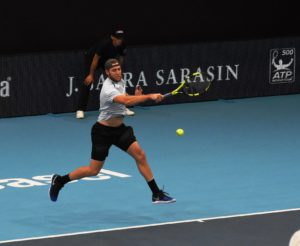
Jack Sock (*92 / USA) – Service 3.0 & Forehand 3.0 combination – 9 of 10 – end of follow through 1 = targeted pronation – very dynamic but still very controlled full-body energy unloading against the target – racket was turned almost full 180° before the elbow will be bent – 2017 Swiss Indoors – Basel / Switzerland
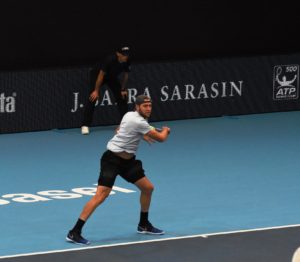
Jack Sock (*92 / USA) – Service 3.0 & Forehand 3.0 combination – 10 of 10 – end of follow through 2 = relaxation – Jack’s body is well-balanced with head/eyes still as most of the energy was spent in the direction of the target, such situation brings besides efficient well-controlled strokes also the possibility of an early preparation for the following stroke/action – 2017 Swiss Indoors – Basel / Switzerland
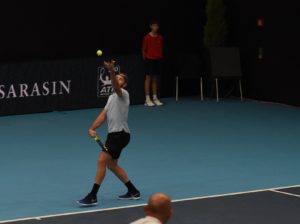
Jack Sock (*92 / USA) – Forehand 3.0 & 2nd topspin service 3.0 combination in a match – 1 of 4 – toss with a perfect eye control – 2017 Swiss Indoors – Basel / Switzerland
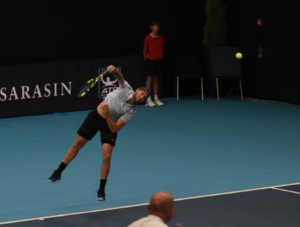
Jack Sock (*92 / USA) – Forehand 3.0 & 2nd topspin service 3.0 combination in a match – 2 of 4 – follow through 1 = targeted pronation goes more to the outside of the player’s dominant side (here right) as this is typical for the topspin service, excellent control of the non-dominant (left) arm – 2017 Swiss Indoors – Basel / Switzerland
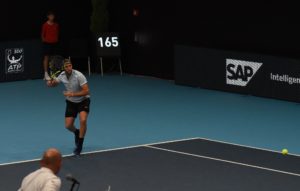
Jack Sock (*92 / USA) – Forehand 3.0 & 2nd topspin service 3.0 combination in a match – 3 of 4 – take-back combined with spacing – this 2nd service was of quite solid speed with its 165 km/h = 103 mph, but opponent was still able to hit quite a solid return into Jack’s backhand corner – 2017 Swiss Indoors – Basel / Switzerland
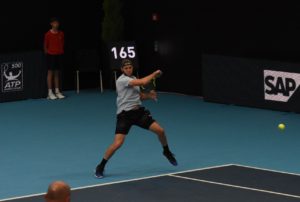
Jack Sock (*92 / USA) – Forehand 3.0 & 2nd topspin service 3.0 combination in a match – 4 of 4 – end of follow through 1 / beginning of follow through 2 – despite very solid return from the opponent towards Jack’s backhand, he was able to run around and come to a forehand with quite a high degree of the body energy unloading – 2017 Swiss Indoors – Basel / Switzerland
This article covers certain aspects of Jack Sock’s service and forehand combination as well as tennis service and forehand in general only! Further photos and more details about his service/forehand and other strokes as well as about the strokes of other players are available upon request at drmgb11(at)gmail.com. Some significant details of this kind necessary for top tennis performance are being discussed also in the seminar “TENNIS 3.0 – Future of the Game”, which is available worldwide upon request – www.tennis30.com / www.tennis30.cz
Photos (October 2017) & text (November 2017) copyright by Dr. Martin G. Baroch. Any further publication of either any of the photos and/or texts with the written permission of the author/copyright owner only!!
